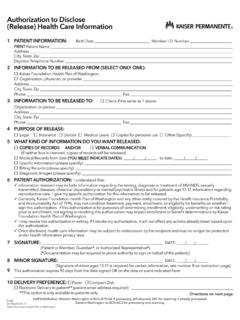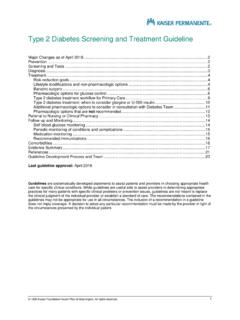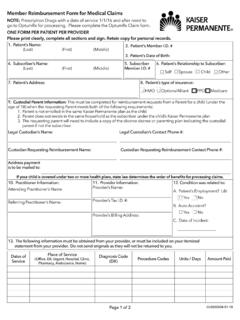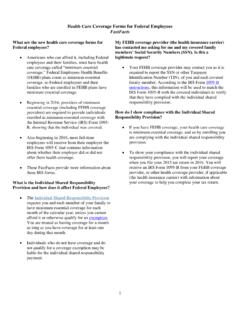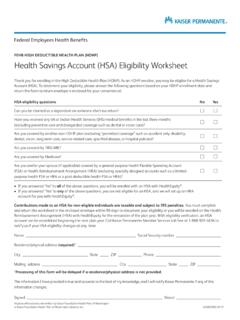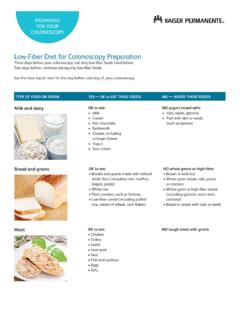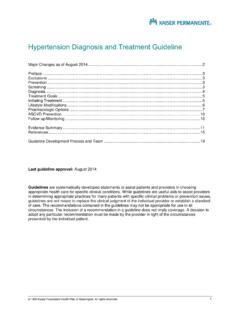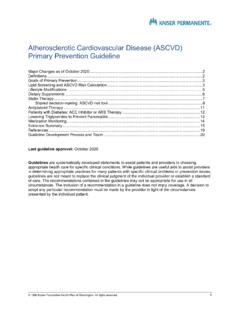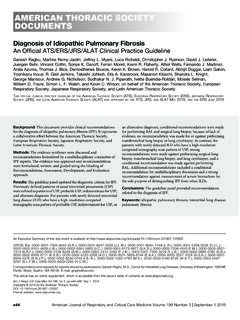Transcription of Pulmonary Embolism Diagnosis & Treatment Guideline ...
1 2017 Kaiser Foundation Health Plan of Washington. All rights Pulmonary Embolism Diagnosis & Treatment Guideline Background .. 2 Evaluation and Diagnosis Adults .. 3 Pregnant women .. 4 Adults with cancer .. 5 Choice of Treatment Setting .. 6 Subsegmental PE: Treatment Versus Surveillance .. 8 Treatment with Anticoagulation Medications .. 9 Recommended testing .. 9 Choice of anticoagulant medications by population .. 9 Dosing of anticoagulant medications .. 11 Duration of anticoagulant medications .. 12 Follow-up and Monitoring .. 12 Evidence Summary .. 15 References .. 22 Guideline Development Process and Team .. 25 Appendix 1: Shared decision making for choosing anticoagulant medication .. 26 Last Guideline approval: October 2017 Guidelines are systematically developed statements to assist patients and providers in choosing appropriate health care for specific clinical conditions.
2 While guidelines are useful aids to assist providers in determining appropriate practices for many patients with specific clinical problems or prevention issues, guidelines are not meant to replace the clinical judgment of the individual provider or establish a standard of care. The recommendations contained in the guidelines may not be appropriate for use in all circumstances. The inclusion of a recommendation in a Guideline does not imply coverage. A decision to adopt any particular recommendation must be made by the provider in light of the circumstances presented by the individual patient. This evidence-based Guideline was developed by Kaiser Permanente Washington (KPWA). 2 Background Pulmonary Embolism (PE) is a relatively common vascular disease with potentially life-threatening complications in the short term.
3 The accurate incidence of the condition is unknown, but it is estimated that 200,000 to 500,000 patients are diagnosed with PE each year in the United States. Many of these cases are diagnosed in the emergency department (White 2016). Traditionally, patients with PE are treated in the hospital (usually for 24 hours but up to 5 or 6 days) for initiation of anticoagulation therapy and monitoring for any clinical deterioration. The introduction of low molecular weight heparin (LMWH) and the non-vitamin K dependent oral anticoagulants, together with the increased ability to accurately stratify patients according to their risk of short-term clinical deterioration, have made it potentially feasible and safe to manage selected low-risk patients in the outpatient setting either entirely or after a short in-hospital observation period.
4 The recent American College of Chest Physicians Guidelines (2016) suggest Treatment at home or early discharge over standard discharge for patients with low-risk PE (2B recommendation). Many physicians still have concerns regarding the outpatient Treatment or early discharge of low-risk PE patients (Singer 2016). The purpose of this Guideline is five-fold: Provide an evidence-based approach to the Diagnosis and management of acute Pulmonary Embolism inclinically stable patients. Identify a population of patients newly diagnosed with PE who can be safely managed as outpatients. Provide guidance on the preferred anticoagulant for initial and long-term therapy, including the use of directoral anticoagulants (DOACs). Improve patient safety and health outcomes for patients with PE. Decrease variation in practice in treating population The recommendations in this Guideline apply to clinically stable outpatients who are: Adults 18 years or older (non-pregnant) with suspected PE.
5 Pregnant women with suspected PE. Adult patients with malignancy with suspected This Guideline does not apply to: Clinically unstable patients with suspected PE. These patients should go directly to CT pulmonaryangiography. Hospitalized patients. Patients with established deep vein thrombosis (DVT). These patients may be referred to the KPWAA nticoagulation/Anemia Management Service (AMS). Note: While DVT is outside the scope of this Guideline , the recommendations for Treatment of Pulmonary Embolism (see p. 9) can also be applied to patients with DVT. Symptoms of Pulmonary Embolism Pleuritic chest pain Shortness of breath Dyspnea Tachycardia HypoxemiaAbbreviations ACCP American College of Chest Physicians PERC Pulmonary Embolism Rule-out Criteria DOACs Direct oral anticoagulants PESI Pulmonary Embolism Severity Index DVT Deep vein thrombosis SSPE Subsegmental Pulmonary Embolism LMWH Low molecular weight heparin UFH Unfractionated heparin PE Pulmonary Embolism VTE Venous thromboembolism 3 PE Evaluation and Diagnosis : Non-pregnant Adults Without Cancer This algorithm is based on ICSI 2013.
6 Outpatient with suspected Pulmonary Embolism , based on symptomsPulmonary Embolism Rule Out Criteria (PERC)A single positive criterion qualifies as a positive result. Patient aged 50 years Pulse rate 100 bpm Pulse oximetry (RA) < 95% Unilateral leg swelling Hemoptysis Surgery or trauma within 4 weeks Prior DVT/PE Oral hormone useAge-adjusted D-dimerOPTIONALP ulmonary Embolism Rule Out Criteria (PERC)NEGATIVEPOSITIVE or PERC NOT DONENEGATIVECT Pulmonary angiographyDetermine Treatment setting and treat for Pulmonary unlikely. Consider other unstable?NOCT Pulmonary angiographyYESPOSITIVEW ells CriteriaWells CriteriaEstimate clinical pretest probability of PE: Clinical signs3 Alternative Diagnosis unlikely3 Heart rate >100 Immobilization previous 4 Previous Hemoptysis1 Malignancy ( Treatment in last 6 months)1PE less likely: 4PE likely: > 4 Wells score 4 Wells score 7 Wells score 5 or 6 Begin anticoagulation without CT Pulmonary angiography to set a baseline should symptoms Pulmonary angiographyIf contraindicated, do VQ D-dimerNEGATIVE or NONDIAGNOSTICL ikelihood of venous thromboembolism (VTE) based on D-dimer?
7 UNLIKELYB ilateral lower limb Doppler ultrasoundLIKELYPE/VTE unlikely. Consider other for venous D-dimerFor age 50, cutoff = 500 ng/mLFor age > 50, cutoff = [age in years] X 10 ng/mL 4 PE Evaluation and Diagnosis : Pregnant Women This algorithm is based on Leung 2012. Outpatient with suspected Pulmonary Embolism , based on symptomsClinically unstable?NOCT Pulmonary angiographyYEST reat for Pulmonary Embolism as lower limb Doppler ultrasoundChest X-ray and CT Pulmonary angiographyPOSITIVENEGATIVELeg symptoms?YESNOPE unlikely. Consider other NEGATIVE If Pulmonary Embolism , treat for PE as inpatient. If other Diagnosis ( , pneumonia, pneumothorax, CHF), treat POSITIVE 5 PE Evaluation and Diagnosis : Adults with Cancer This algorithm is based on NCCN 2016. Outpatient with suspected Pulmonary Embolism , based on symptomsChest X-rayandAge-adjusted D-dimer Wells CriteriaNEGATIVED etermine Treatment setting and treat for Pulmonary Pulmonary angiographyPE unlikely.
8 Consider other for other condition ( , pneumonia, pneumothorax, CHF)?Treat CriteriaEstimate clinical pretest probability of PE: Clinical signs3 Alternative Diagnosis unlikely3 Heart rate >100 Immobilization previous 4 Previous Hemoptysis1 Malignancy ( Treatment in last 6 months)1PE less likely: 4PE likely: > 4 Wells score 5 Wells score 4 Age-adjusted D-dimerFor age 50, cutoff = 500 ng/mLFor age > 50, cutoff = [age in years] X 10 ng/mL 6 PE Treatment : Choice of Setting Pregnant women All pregnant women with confirmed acute PE should be treated in an inpatient setting. Non-pregnant adults (with or without cancer) KPWA recommends using the American College of Chest Physicians (ACCP) criteria below to determine which patients with confirmed acute PE are suitable for outpatient Treatment and can be safely discharged from urgent care to home.
9 (Note: For clinics with short-stay observation units, an additional option is to discharge patients to that unit for shared decision making around choice of Treatment setting.) ACCP criteria for outpatient Treatment of acute PE Patient is clinically stable with good cardiopulmonary reserve. Patient has no contraindications, such as recent bleeding, severe renal or liver disease, or severe thrombocytopenia (< 70,000/mm3). Patient has none of the following: right ventricular dysfunction shown on echocardiogram, or signs of right heart strain on CTPA, or increased cardiac biomarkers (troponin or brain natriuretic peptide) levels. Patient is expected to be compliant with Treatment . Patient feels well enough to be treated at home. Patient has a Pulmonary Embolism Severity Index (PESI) score of < 85: Pulmonary Embolism Severity Index (PESI) The PESI is a validated, accurate, easy-to-use tool that can be used at no cost.
10 It can be accessed at Predictor Points Age +1 per year Male sex +10 Heart failure +10 Chronic lung disease +10 Arterial oxygen saturation < 90% +20 Pulse 110 beats per minute +20 Respiratory rate 30 breaths per minute +20 Temperature < 36 F +20 Cancer +30 Systolic blood pressure < 100 mm Hg +30 Altered mental status +60 Risk classification based on PESI score Risk PESI score 30-day mortality Recommendation Class I: Very low risk Class II: Low risk < 65 66 85 to to Offer outpatient Treatment to patients in Classes I and II. Discuss the benefits and risks of outpatient Treatment . Class III: Intermediate risk Class IV: High risk Class V: Very high risk 86 105 106 125 > 125 to to to Provide inpatient Treatment for patients in Classes III V. Inpatient setting All pregnant women All patients not meeting ACCP criteria Patients electing inpatient Treatment via shared decision makingOutpatient setting Including short-stay observation unit, where available.

